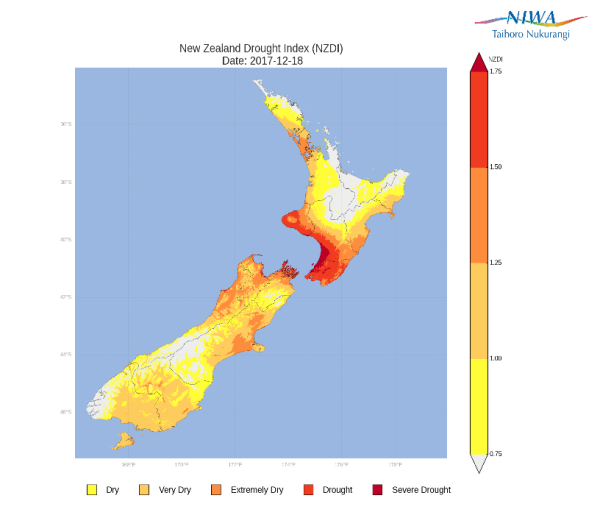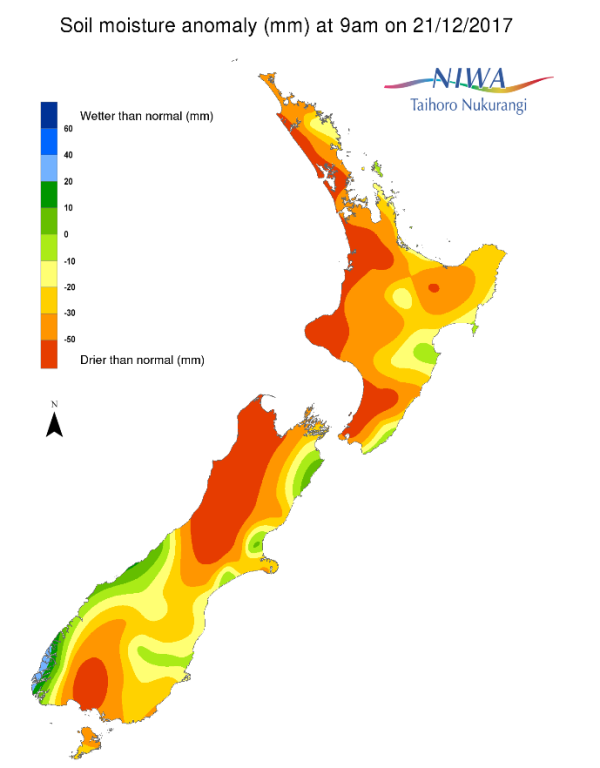A weekly update describing soil moisture across the country to help assess whether severely to extremely dry conditions are occurring or imminent. Regions experiencing these soil moisture deficits are deemed “hotspots”. Persistent hotspot regions have the potential to develop into drought.
Facts: Soil Moisture
Across the North Island, soil moisture levels generally only underwent minor changes during the past week. Minor improvements were observed along the east coast, notably in coastal Wairarapa and Hawke’s Bay, and farther west in Bay of Plenty. Conversely, minor decreases in soil moisture occurred in northern Waikato and the Far North District. The driest soils across the North Island compared to normal for this time of the year are found in Kaipara District, northern Auckland, western and northern Waikato, much of Taranaki, and Manawatu District and Palmerston North south to Porirua, while the wettest soils for this time of the year are located in small portions of Hastings District, coastal Wairarapa, and Mahia Peninsula.
North Island hotspots are currently in place across Kaipara District, nearly all of Auckland, much of northern Waikato, coastal Taranaki, coastal Manawatu-Whanganui south to Kapiti Coast and Wellington City, Masterton District north to Central Hawke’s Bay, and near East Cape. Elsewhere along the east coast previous hotspots dissipated due to rainfall late last week.
Much of the lower North Island is currently experiencing meteorological drought, including a large portion of Taranaki, coastal Manawatu-Whanganui, and most of Wellington. In addition, severe meteorological drought is in place from Manawatu District south to Kapiti Coast. A small portion of northern Marlborough is also experiencing meteorological drought.
(For more information on drought conditions check the New Zealand dought monitor)
Across the South Island, soil moisture levels generally changed very little during the past week. However, a notable exception was a significant improvement in coastal Kaikoura and eastern Marlborough. Another minor improvement was observed in eastern Southland and Clutha District. The driest soils across the South Island compared to normal for this time of the year are found in Tasman, Nelson, the northern West Coast, interior Canterbury and southern Southland, while the wettest soils for this time of the year are found in Fiordland.
South Island hotspots are currently located in northern Tasman, Nelson, interior central Canterbury, Banks Peninsula, coastal Selwyn District, and a small portion of southern Southland.
Outlook and Soil Moisture
A weak trough about the North Island may produce isolated showers in central and northern areas from Friday through to Christmas Eve (22nd-24th December), but rainfall totals in these areas could be 10 mm or less. However, isolated locations under heavier showers could receive as much as 15 mm. Christmas Day will be mostly dry before a front moves up the North Island on Boxing Day, where many locations could receive 5-15 mm. On Wednesday and Thursday (27th-28th December) there is a possibility for developing low pressure to bring additional rainfall to Gisborne and Hawke’s Bay, however this outcome remains low confidence at this time. Overall during the next week, the upper North Island may receive less than 10 mm of rainfall, with 10-25 mm possible elsewhere. Should the post-Boxing Day low pressure occur, more substantial amounts would be possible in Gisborne and Hawke’s Bay.
Due to the expected rainfall and its geographic placement in the North Island, soil moisture levels will likely continue to decrease across northern and western areas during the next week, with the possibility for little change in central areas. Should the post-Boxing Day low pressure occur, improvements in soil moisture levels could occur in Gisborne and Hawke’s Bay. This may lead to strengthening and enlargement of existing hotspots in Northland, Auckland, northwestern Waikato, Taranaki, and Manawatu-Whanganui to Wellington, while further improvements may occur along the east coast.
In the South Island, a weak front could bring a couple millimetres of rain to eastern areas this evening. High pressure will then be the dominant feature from Friday through to Christmas Eve (22nd-24th December), with little to no rain expected. A front will move up the South Island on Christmas Day, bringing substantial rainfall of 25-50 mm to the West Coast and Tasman, but less than 15 mm to locations east of the Southern Alps. More pop-up showers in Otago and Canterbury on Boxing Day could produce isolated 10 mm amounts before high pressure returns on Wednesday and Thursday.
Additional improvements in soil moisture levels will be likely during the next week along the West Coast and to a lesser extent in Tasman, while minor improvements could occur in Otago and southern Canterbury. However, decreases in soil moisture may occur from central Canterbury to Marlborough due to low rainfall amounts. Hotspots in northern Tasman, Nelson, interior central Canterbury and Southland are unlikely to change significantly during the next week, while a return to near-Hotspot conditions could occur in Kaikoura and eastern Marlborough.
Background:
Hotspot Watch: a weekly advisory service for New Zealand media. It provides soil moisture and precipitation measurements around the country to help assess whether extremely dry conditions are imminent.
Soil moisture deficit: the amount of water needed to bring the soil moisture content back to field capacity, which is the maximum amount of water the soil can hold.
Soil moisture anomaly: the difference between the historical normal soil moisture deficit (or surplus) for a given time of year and actual soil moisture deficits.
Definitions: “Extremely” and “severely” dry soils are based on a combination of the current soil moisture status and the difference from normal soil moisture (see soil moisture maps)



